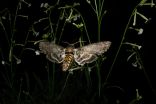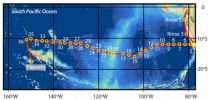Assessing quality of flowing waters with DNA analyses
Organisms in streams and rivers shed light on quality of waters
2015-07-09
(Press-News.org) The quality of waters can be assessed using of the organisms occurring therein. This approach often results in errors, because many species look alike. Therefore, new methods focus on DNA analyses instead. Biologists at the Ruhr-Universität Bochum (RUB) have optimised the process so that they are now able to identify many organisms at once in a quick and reliable manner using short DNA sequences. The results have been published in the PLOS ONE magazine.
Expert knowledge for species identification threatens to disappear
Industry, agriculture and human settlement put a strain on bodies of water; some organisms cannot survive due to the changing conditions in streams and rivers. Accordingly, their existence sheds light on the quality of the habitat. However, the number of experts able to identify the small animals on the basis of their appearance is in decline; only a few junior researchers are active in this field. RUB researchers from the Department Animal Ecology, Evolution and Biodiversity help preserve expert knowledge.
Database with "DNA barcodes"
For this purpose, they are creating a database in collaboration with the "German Barcode of Life Project": in the first step, qualified experts identify the water organisms based on their appearance. Subsequently, a short characteristic segment of the animals' genome - i.e. the barcode - is decoded and fed into the database. Someone who wishes to find out which species are represented in a body of water, takes a water sample, sequences the DNA of the organisms contained therein and matches it against the database. Vasco Elbrecht and Dr Florian Leese have developed an innovative lab protocol which renders this so-called DNA barcoding much faster than hitherto. They are able to identify more than thousand animals within a week after taking the sample. Even now in the development stage, the method identifies more than 80 per cent of the species correctly. It is thus more reliable than species identification based on external characteristics, and the biologists from Bochum are convinced that they will optimise the quota in the near future.
Assessment systems have to be adjusted to the new method
In their study, the Bochum-based biologists have also demonstrated the limitations of DNA barcoding. Using this method, it cannot be determined how many individuals of a certain species can be found in a body of water. The established assessment criteria for water quality, on the other hand, do include such data. "This is a problem for available assessment systems," says Florian Leese. "However, running waters are very dynamic; the frequency of species varies strongly for natural reasons over time. Therefore, it makes sense to record the quality based on conclusive species lists, without focusing too much on frequency."
INFORMATION:
Bibliographic record
V. Elbrecht, F. Leese (2015): Can DNA-based ecosystem assessments quantify species abundance? Testing primer bias and biomass - sequence relationships with an innovative metabarcoding protocol, PLOS ONE, DOI: 10.1371/journal.pone.0130324, Link: http://dx.plos.org/10.1371/journal.pone.0130324
Further information
Dr Florian Leese, Department of Animal Ecology, Evolution and Biodiversity, Faculty of Biology and Biotechnology at the Ruhr-Universität, 44780 Bochum, Germany, phone: +49/234/32-25072, Email: florian.leese@rub.de
Image online
An image related to this press release can be found online at http://aktuell.ruhr-uni-bochum.de/pm2015/pm00093.html.en.
Editor: Dr Julia Weiler
ELSE PRESS RELEASES FROM THIS DATE:
2015-07-09
Researchers at the University of Liverpool's Institute of Infection and Global Health (IGH) have discovered a common cause of heart damage in patients with sepsis.
Sepsis is the most common cause of death in hospitalised critically ill people and affects up to 18 million people world-wide annually.
The electrical and mechanical malfunctions of the heart have been poorly understood in sepsis, with underdeveloped clinical management strategies, as a consequence. This new discovery, however, promises to benefit a high number of patients with heart failure or rhythm ...
2015-07-09
Since 1994, researchers at Case Western Reserve University have studied mothers--some who used cocaine while pregnant and others who did not--to understand how the drug affected their children's cognitive and social development.
Their latest findings suggest a link between prenatal cocaine exposure and an adolescent's likelihood to have sexual intercourse before age 15.
Teens who were prenatally cocaine exposed (PCE) were 2.2 times more likely to engage in sexual intercourse before age 15 than those who weren't, yet how PCE affects early sexual behavior may differ ...
2015-07-09
This news release is available in German.
Some pollinators not only provide fertilization services for flowering plants, they also lay their eggs on the plants' leaves after they have visited the flowers. Voracious caterpillars hatch from these eggs and their enormous appetite can easily kill the plants. So when plants advertise for pollinators they frequently also attract herbivores. Scientists from the Max Planck Institute for Chemical Ecology in Jena, Germany, demonstrated in field trials that the flowers of the coyote tobacco Nicotiana attenuata are able ...
2015-07-09
AMES, Iowa - Developing any habit--good or bad--starts with a routine, and exercise is no exception. The trick is making exercise a habit that is hard to break. According to a new Iowa State University study, that may be easier to accomplish by focusing on cues that make going for a run or to the gym automatic.
Some interventions designed to help people start and continue exercising may focus on the execution habit, or an exact routine to follow at the gym, said Alison Phillips, an assistant professor of psychology at Iowa State. However, Phillips' research, published ...
2015-07-09
MANHATTAN, Kansas -- A new study led by a Kansas State University geneticist has shown that genomic signatures of adaptation in crop plants can help predict how crop varieties respond to stress from their environments.
It is the first study to document that these genomic signatures of adaptation can help identify plants that will do well under certain stresses, such drought or toxic soils, said Geoff Morris, assistant professor of agronomy at Kansas State University and a researcher affiliated with the university's Feed the Future Innovation Lab for Collaborative Research ...
2015-07-09
Since their first discovery a generation ago, it has been recognized that hydrothermal vents at the bottom of the deep dark oceans represented unique habitats for exotic forms of life previously unknown to science. But what has gone quite overlooked, until now, is the role that these "rare, exotic" systems might play in regulating the global-scale chemistry of the oceans and, hence, the health and productivity of our planet as a whole.
A new study by researchers from University of Washington (UW), Old Dominion University (ODU), Woods Hole Oceanographic Institution (WHOI), ...
2015-07-09
Strategies to support healthier diets among seniors need to take into account differences between elderly men and women, according to UBC research.
The two groups had varying responses to a tactic thought to boost seniors' fruit and vegetable intake, according to a study published in Appetite.
The study explored which types of social support encouraged seniors to boost their daily intake of fruits and vegetables.
Social support, typically provided by friends and family, comes in different forms. It ranges from emotional support, which bolsters one's sense of self, ...
2015-07-09
One of the most important things to understand in battery technology is the precise physical and chemical processes that occur at the electrode/electrolyte interface. However, microscopic understanding of these processes is quite limited due to a lack of suitable probing techniques. Now, researchers at the US Department of Energy's (DOE) Lawrence Berkeley National Laboratory (Berkeley Lab) and the University of California, Berkeley, have developed a new technique that enables sensitive and specific detection of molecules at the electrode/electrolyte interface.
This new ...
2015-07-09
Ann Arbor, MI, July 8, 2015 - Nearly 800,000 people in the U.S. suffer a stroke each year. Stroke is responsible for one out of every 19 deaths in the U.S. and it is a leading cause of disability. A new study published in the American Journal of Preventive Medicine found that secondhand smoke (SHS) increases the risk of stroke by about 30 percent for nonsmokers.
Using data from the Reasons for Geographic and Racial Differences in Stroke (REGARDS) study, a national, population-based, longitudinal study investigating cardiovascular disease events and mortality endpoints ...
2015-07-09
New York, 9 July - Investing up to 3.5% of a nation's GDP in science, technology and innovation - including basic science and education - is a key benchmark for advancing sustainable development effectively, leading experts say.
In papers released July 9 in New York, international scientists advising UN Secretary-General Ban Ki-moon say closing the gap between developed and developing countries depends on first closing international science, technology and innovation (STI) investment gaps.
According to the UN SG's 26-member Scientific Advisory Board: "While a target ...
LAST 30 PRESS RELEASES:
[Press-News.org] Assessing quality of flowing waters with DNA analyses
Organisms in streams and rivers shed light on quality of waters




